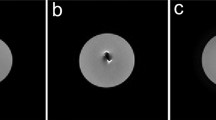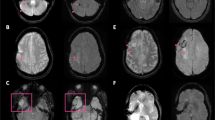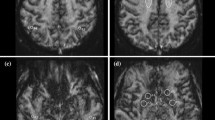Abstract.
The aim of this study was to evaluate the sensitivity of gradient-and-spin-echo (GRASE) sequences to susceptibility effects. GRASE sequences with 21 and 33 echoes per echo train were compared with a T2-weighted FSE sequence with an echo train length of 5 by means of MRI in phantoms, volunteers (n = 10), and patients (n = 19) with old hemorrhagic brain lesions. All experiments were performed on a 1.0-T clinical MR system (Impact Expert, Siemens AG, Erlangen, Germany) with constant imaging parameters. Contrast-to-noise ratios (CNRs) of tubes doped with iron oxides at different concentrations, of brain areas with physiological iron deposition (red nucleus, substantia nigra), and of areas of old brain hemorrhage were calculated for FSE and GRASE pulse sequences. Areas of old brain hemorrhage were also qualitatively analyzed for the degree of visible susceptibility effects by blinded reading. The CNR of iron oxide tubes and iron-containing brain areas decreased with increasing echo trains of GRASE sequences. The CNR of GRASE sequences decreased when compared with CNR of their FSE counterparts (GRASE 21 echo trains 23.8 ± 0.8, FSE 5 echo trains 26.7 ± 0.9; p≤ 0.01). Qualitative analysis confirmed these measurements. FSE with an ETL of 5 demonstrated significantly stronger susceptibility effects than their GRASE counterpart with an ETL of 21. The results demonstrate that GRASE sequences do not necessarily compensate for the reduced sensitivity of FSE to susceptibility effects. The complex signal behavior of GRASE makes conventional SE, gradient echo, or FSE sequences containing shorter echo trains preferable when patients with intracranial hemorrhage are clinically evaluated.
Similar content being viewed by others
Author information
Authors and Affiliations
Additional information
Received 12 November 1997; Revision received 18 April 1997; Accepted 1 September 1997
Rights and permissions
About this article
Cite this article
Allkemper, T., Reimer, P., Schuierer, G. et al. Study of susceptibility-induced artefacts in GRASE with different echo train length. Eur Radiol 8, 834–838 (1998). https://doi.org/10.1007/s003300050481
Issue Date:
DOI: https://doi.org/10.1007/s003300050481




